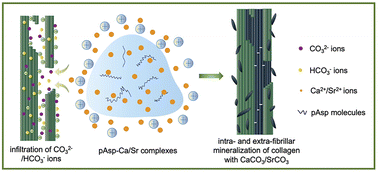Intrafibrillar mineralization of type I collagen with calcium carbonate and strontium carbonate induced by polyelectrolyte–cation complexes†
Abstract
Calcium carbonate (CaCO3), possessing excellent biocompatibility, bioactivity, osteoconductivity and superior biodegradability, may serve as an alternative to hydroxyapatite (HAp), the natural inorganic component of bone and dentin. Intrafibrillar mineralization of collagen with CaCO3 was achieved through the polymer-induced liquid precursor (PILP) process for at least 2 days. This study aims to propose a novel pathway for rapid intrafibrillar mineralization with CaCO3 by sequential application of the carbonate–bicarbonate buffer and polyaspartic acid (pAsp)-Ca suspension. Fourier transform infrared (FTIR) spectroscopy, zeta potential measurements, atomic force microscopy/Kelvin probe force microscopy (AFM/KPFM), and three-dimensional stochastic optical reconstruction microscopy (3D STORM) demonstrated that the carbonate–bicarbonate buffer significantly decreased the surface potential of collagen and CO32−/HCO3− ions could attach to collagen fibrils via hydrogen bonds. The electropositive pAsp–Ca complexes and free Ca2+ ions are attracted to and interact with CO32−/HCO3− ions through electrostatic attractions to form amorphous calcium carbonate that crystallizes gradually. Moreover, like CaCO3, strontium carbonate (SrCO3) can deposit inside the collagen fibrils through this pathway. The CaCO3-mineralized collagen gels exhibited better biocompatibility and cell proliferation ability than SrCO3. This study provides a feasible strategy for rapid collagen mineralization with CaCO3 and SrCO3, as well as elucidating the tissue engineering of CaCO3-based biomineralized materials.



 Please wait while we load your content...
Please wait while we load your content...